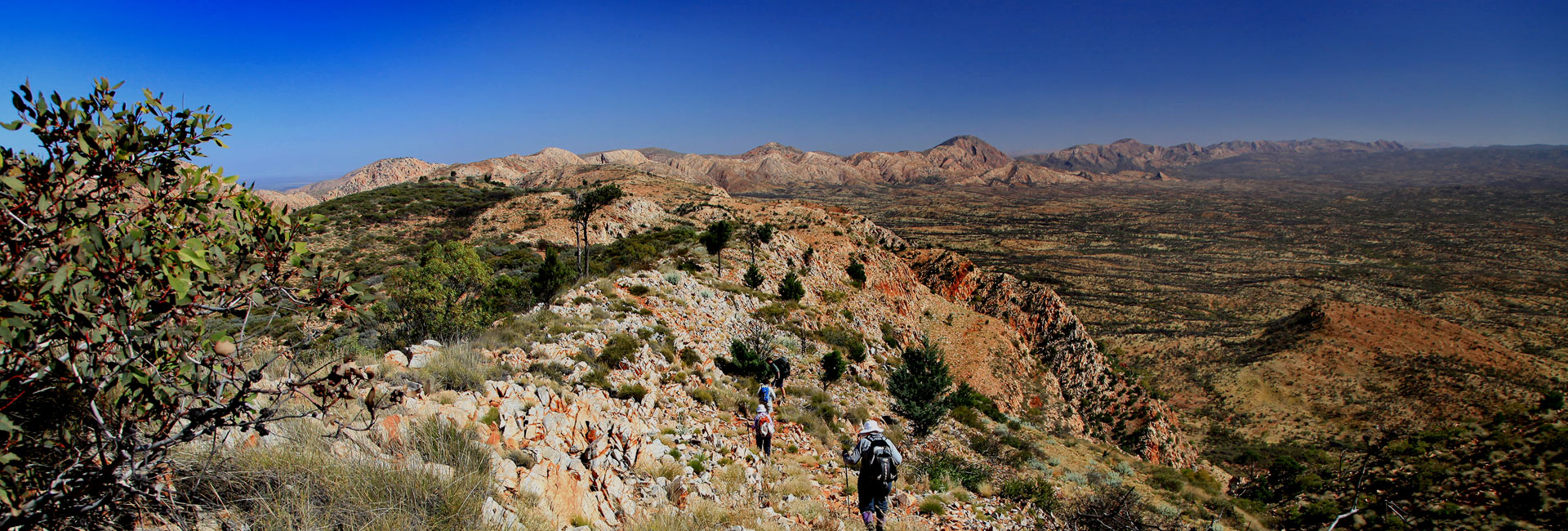Trek Tours Australia Kakadu Explorer Trek
KAKADU : The best trek our guides have ever done
Story by Matt Sykes

One of our most experienced guides Brad studying a map with Joel looking on
(Photo: Jackie Crane)
Kakadu is a place that all Trek Tours’ guides want to work. It’s like a badge of honour though, you have to be working with the company for a time before the opportunity presents itself. Everyone knows it’s different up there, more real somehow. You’re off-track, carrying everything in and everything out. It’s just you and an ancient landscape, for nine days.
When you see guides returning from a stint ‘Up North’ they have a certain glow about them, like they’ve just stepped out of another world. But being the unassuming and humble characters that they are they don’t tell you much, and I think that has a lot to do with the fact that such experiences are hard to explain. You’ll hear Brad talk about the Aboriginal culture and rock art sites, places that must be felt first-hand.

Brad in his element, studying nature’s tiny beauties (Photo: Jackie Crane)
We heard back from a guest recently, Madeleine, who walked the Kakadu Explorer last year. She described it as an awe-inspiring and life-changing experience. So much so that she was ‘still drawing from the energy of the experience’ a year later. As a tour company we can only do so much to facilitate a deep experience but when you work with places like Kakadu, the land kind of takes you over and all you have to do is go along with it. Guests that open themselves up benefit the most.
When you look at scenes like the one below it’s hard to imagine not being deeply affected by such a place. Those ripples in the foreground rock were laid millions and millions of years ago. The gorge has been cut by water, an element that people from Australia’s south would typically see as soft and gentle. It looks still and serene now but when we’re walking in Tasmania over summer this dry river becomes a raging torrent. Contemplating unfathomable periods of time and natural processes are just one of the joys of the Kakadu Explorer.

Deep time (Photo: Jackie Crane)
The traditional custodians of this Country are the Bininj and Mungguy people. (Bininj in the north of Kakadu National Park and Mungguy in the south) Their cultural connections to this landscape go back more than 50,000 years. (1) Some of the rock art that you’ll be lucky enough to experience on the trip traces their heritage. In 1981 Kakadu’s ancient cultural values, as well as its natural values, were celebrated by being added to the World Heritage list. (2) On top of that, Kakadu forms part of Australia’s largest national park, ‘covering almost 20,000 square kilometres. That’s nearly half the size of Switzerland’. (1) It’s a big, old place.
On some walks there’s moments when time seems to stand still. Everything just slows down, your senses are alive but your mind is calm. Kakadu has more than it’s fair share of these moments. The images below are a couple of such examples, captured by past guest Jackie Crane.

Time standing still (Photo: Jackie Crane)

Dusk (Photo: Jackie Crane)
Timing is everything out here and we sync our Kakadu walks to fit the seasons. Our trips occur during Wurrgeng, a period from mid-June to mid-August that the Bininj/Mungguy people regard as ‘cold weather’ time. Mind you, cold weather is relative -‘humidity is low, daytime temperatures are around 30°C and night-time temperatures are around 17°C’. (3) We set out early in the morning and aim to be out of the heat, possibly even bathing in a waterhole or two, before it gets too hot.
Interestingly the Traditional Owners recognise six seasons in this region. My favourite is “Knock ‘em down storm season”!
Gudjewg (Monsoon Season) – December to March
Banggerreng (Knock ‘em down storm season) – April
Yegge (Cooler but still humid season) – May to mid-June
Wurrgeng (Cold weather season) – mid-June to mid-August
Gurrung (Hot dry weather) – mid-August to mid-October
Gunumeleng (Pre-monsoon storm season) – mid-October to late-December (3)

Sacred ritual, the team enjoying an afternoon siesta (Photo: Jackie Crane)
You know the feeling when you’ve been walking all day and you arrive at camp, take your pack off and you sit in stillness reflecting upon the memories that you’ve just created. Everyone finds their own space.
One of the beautiful things in Kakadu is being able to a light a fire at night. Nothing outrageous, just a modest flame to cook some tucker and sit by, mesmerised. Yep, Kakadu is a treasure and we love sharing it with people. At the same time that it changes your life, it changes ours’.

Camp oven on simmer (Photo: Jackie Crane)
For more information about our 9 day Kakadu Explorer Trek please visit here – https://www.trektoursaustralia.com.au/tour/kakadu-explorer-walking-tours/
References
(1) Parks Australia (2013-2016) Introduction to Bininj/Mungguy culture. Accessed on June 2 2016 from http://www.parksaustralia.gov.au/kakadu/people/culture.html
(2) Commonwealth of Australia (2016) World Heritage Listing and RAMSAR Convention on wetlands. Accessed on June 2 2016 from https://www.environment.gov.au/topics/national-parks/kakadu-national-park/world-heritage-listing
(3) Commonwealth of Australia (2016) Seasons of Kakadu. Accessed on June 2 2016 from https://www.environment.gov.au/topics/national-parks/kakadu-national-park/natural-environment/six-seasons









